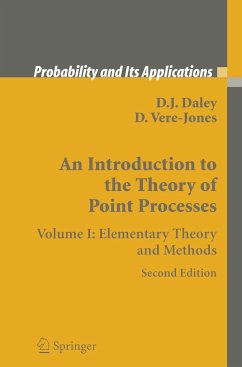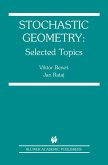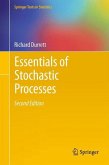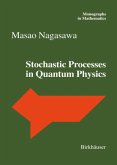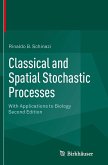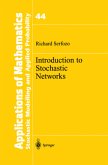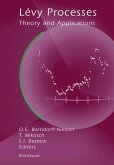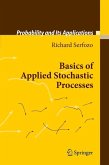Point processes and random measures find wide applicability in telecommunications, earthquakes, image analysis, spatial point patterns, and stereology, to name but a few areas. The authors have made a major reshaping of their work in their first edition of 1988 and now present their Introduction to the Theory of Point Processes in two volumes with sub-titles "Elementary Theory and Models" and "General Theory and Structure".
Volume One contains the introductory chapters from the first edition, together with an informal treatment of some of the later material intended to make it more accessible to readers primarily interested in models and applications. The main new material in this volume relates to marked point processes and to processes evolving in time, where the conditional intensity methodology provides a basis for model building, inference, and prediction. There are abundant examples whose purpose is both didactic and to illustrate further applications of theideas and models that are the main substance of the text.
Volume Two returns to the general theory, with additional material on marked and spatial processes. The necessary mathematical background is reviewed in appendices located in Volume One. Daryl Daley is a Senior Fellow in the Centre for Mathematics and Applications at the Australian National University, with research publications in a diverse range of applied probability models and their analysis; he is co-author with Joe Gani of an introductory text in epidemic modelling. David Vere-Jones is an Emeritus Professor at Victoria University of Wellington, widely known for his contributions to Markov chains, point processes, applications in seismology.
Volume One contains the introductory chapters from the first edition, together with an informal treatment of some of the later material intended to make it more accessible to readers primarily interested in models and applications. The main new material in this volume relates to marked point processes and to processes evolving in time, where the conditional intensity methodology provides a basis for model building, inference, and prediction. There are abundant examples whose purpose is both didactic and to illustrate further applications of theideas and models that are the main substance of the text.
Volume Two returns to the general theory, with additional material on marked and spatial processes. The necessary mathematical background is reviewed in appendices located in Volume One. Daryl Daley is a Senior Fellow in the Centre for Mathematics and Applications at the Australian National University, with research publications in a diverse range of applied probability models and their analysis; he is co-author with Joe Gani of an introductory text in epidemic modelling. David Vere-Jones is an Emeritus Professor at Victoria University of Wellington, widely known for his contributions to Markov chains, point processes, applications in seismology.
From the reviews of the second edition:
"This is an important treatise on the mathematical theory relevant to a wide variety of random processes...The reader will find excellent treatments of important advanced topics such as Cox, renewal, Wold, marked, cluster, and other specialized processes, plus concise but useful appendices on topology, measure theory, metric spaces, martingales, and the like." -- Technometrics, May 2004
"This revision splits the lengthy first version into two volumes now subtitled Volume I: Elementary Theory and Methods and Volume II: Models and General Theory and Structure...this first volume is well worth its price." -- Journal of the American Statistical Association, September 2004
"The theory of point processes has undergone an explosive expansion in the last two decades. There was a genuine need for a single source that would contain a survey of the general theory of Point Process accessible to beginning graduate students and researchers in the field but at the same time would include some of the more recent - though relatively advanced and technically difficult - developments in the area. The present edition of the book addresses that need quite successfully." -- Alok Goswami, Sankhya, Vol. 67 (1), 2005
"It is a pleasure to announce that a second edition of the classic book 'An Introduction to the Theory of Point Processes' has been published. ... many chapters and sections were thoroughly reworked. This holds true in particular for the exercises, which are obviously produced with particular love. ... The reviewer is sure that the owners of the first edition will buy also the second, and for many younger readers it will become the beloved key reference to point processes." -- Dietrich Stoyan, Metrika, May, 2004
"The second edition of this monograph is divided into two volumes. The first one is concentrated on introductory material and models, the second one on structure and general theory. ... suitable as a textbook with many exercises for beginners as well as a source for scientists interested in high level applications of point processes." -- Uwe Küchler, Zentralblatt MATH, Vol. 1026, 2004
"The first edition of this book by two major research workers in the field speedily established itself as an authoritative account of an important and rapidly developing subject. In this substantially revised and expanded second edition, the authors have wisely decided to divide the book into two parts leaving some of the very technical material ... to a second volume. ... The book is likely to establish itself quickly as a major contribution to the field." -- D. R. Cox, Short Book Reviews, Vol. 23 (2), 2003
"This is an important treatise on the mathematical theory relevant to a wide variety of random processes...The reader will find excellent treatments of important advanced topics such as Cox, renewal, Wold, marked, cluster, and other specialized processes, plus concise but useful appendices on topology, measure theory, metric spaces, martingales, and the like." -- Technometrics, May 2004
"This revision splits the lengthy first version into two volumes now subtitled Volume I: Elementary Theory and Methods and Volume II: Models and General Theory and Structure...this first volume is well worth its price." -- Journal of the American Statistical Association, September 2004
"The theory of point processes has undergone an explosive expansion in the last two decades. There was a genuine need for a single source that would contain a survey of the general theory of Point Process accessible to beginning graduate students and researchers in the field but at the same time would include some of the more recent - though relatively advanced and technically difficult - developments in the area. The present edition of the book addresses that need quite successfully." -- Alok Goswami, Sankhya, Vol. 67 (1), 2005
"It is a pleasure to announce that a second edition of the classic book 'An Introduction to the Theory of Point Processes' has been published. ... many chapters and sections were thoroughly reworked. This holds true in particular for the exercises, which are obviously produced with particular love. ... The reviewer is sure that the owners of the first edition will buy also the second, and for many younger readers it will become the beloved key reference to point processes." -- Dietrich Stoyan, Metrika, May, 2004
"The second edition of this monograph is divided into two volumes. The first one is concentrated on introductory material and models, the second one on structure and general theory. ... suitable as a textbook with many exercises for beginners as well as a source for scientists interested in high level applications of point processes." -- Uwe Küchler, Zentralblatt MATH, Vol. 1026, 2004
"The first edition of this book by two major research workers in the field speedily established itself as an authoritative account of an important and rapidly developing subject. In this substantially revised and expanded second edition, the authors have wisely decided to divide the book into two parts leaving some of the very technical material ... to a second volume. ... The book is likely to establish itself quickly as a major contribution to the field." -- D. R. Cox, Short Book Reviews, Vol. 23 (2), 2003

